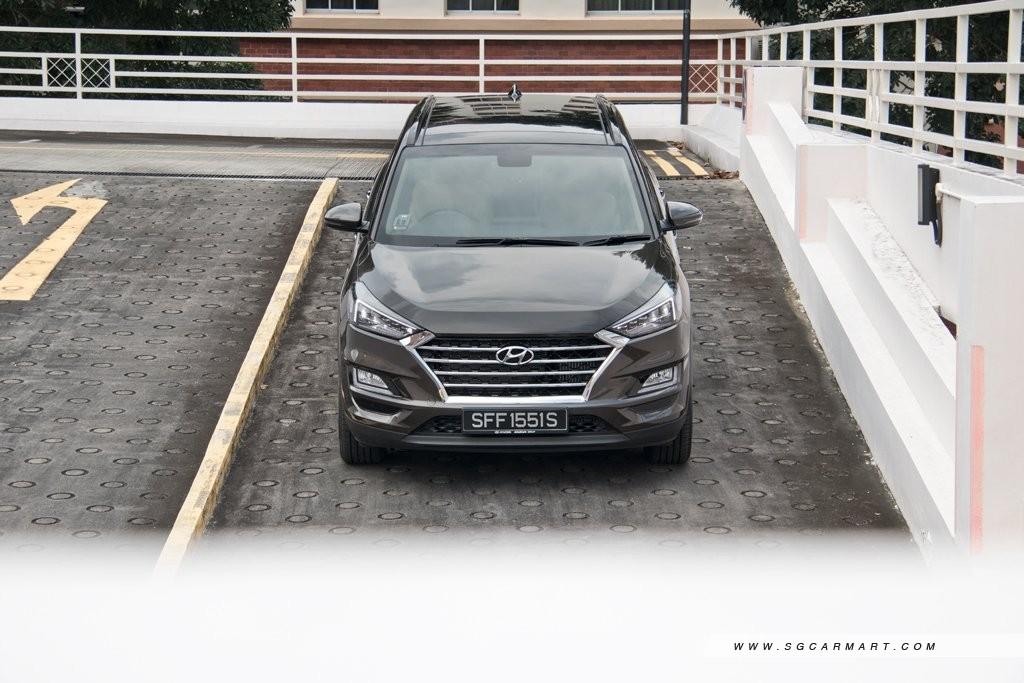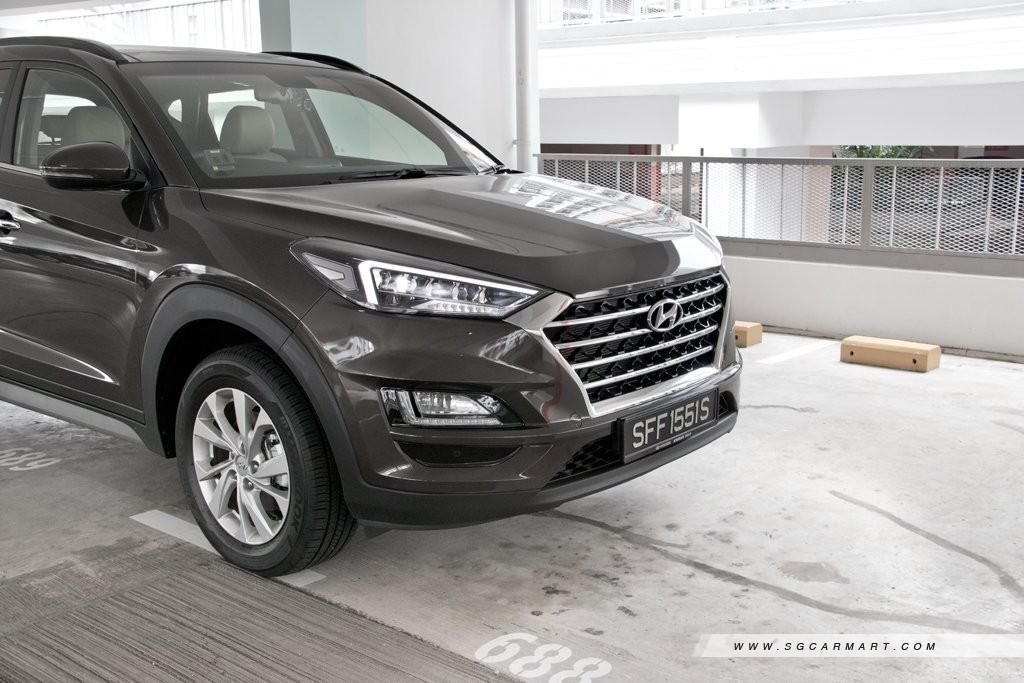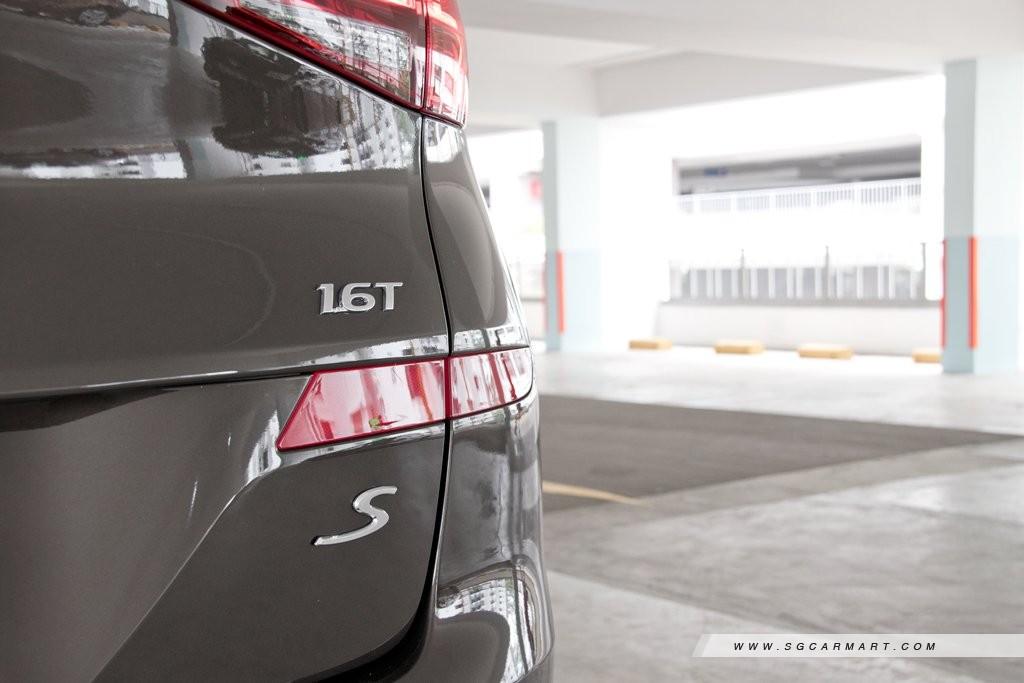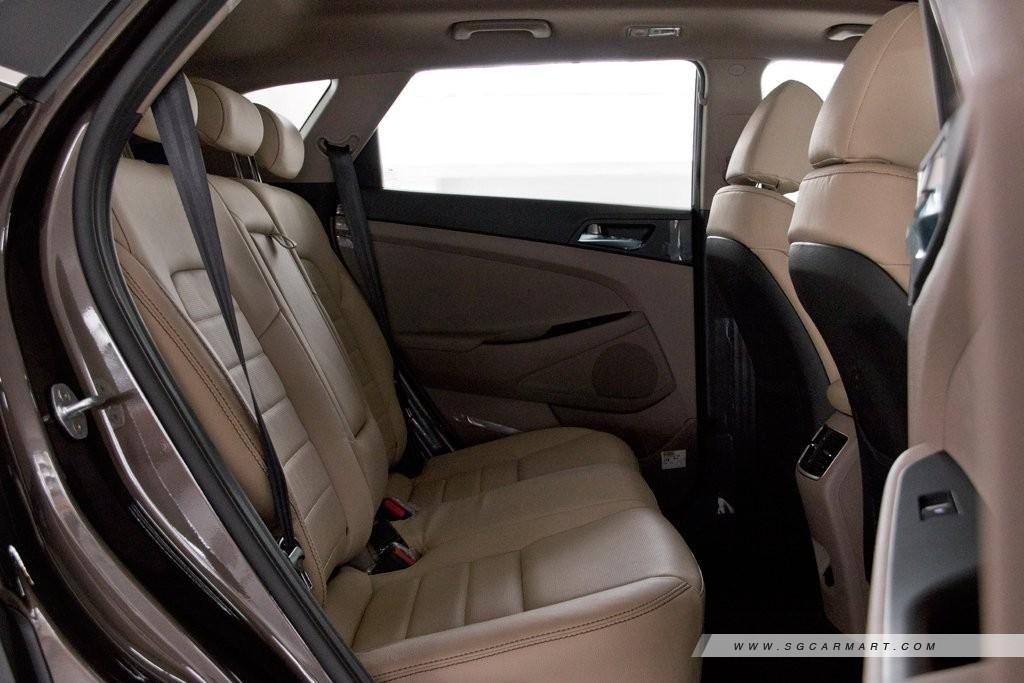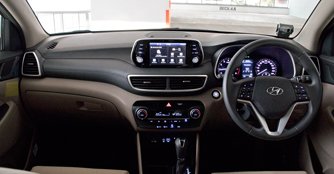Hyundai Tucson 1.6 Turbo 'S' (A) Facelift Review
19 Oct 2018|26,518 views
Facelift (What's New)
Tweaked seven-speed dual=clutch gearbox for faster response
Auto dimming rear view mirror
LED taillights and headlamps with daytime running lights
New 7.0-inch dashboard-mounted infotainment system
Comes with electronic parking brake as standard
Thanks to technological advancement, smarter engineering and functional yet creative designing, it's hard to find an incompetent SUV amongst the brands that we often see on the roads today.
Hyundai is one of those brands.
Launched two years ago, the impressive Hyundai Tucson was fitted with a new 1.6-litre turbocharged engine. Now, it has received a facelift.
Mild changes but big improvement
Changes are mild here, but they add up to make a huge improvement to the third generation Tucson.
With its dominating new grille, new full LED headlamps with daytime running lights and new LED rear lamps, the facelifted Korean model is a modern-looking mid-sized SUV that scores high in the appearance department.
As a matter of fact, in our eyes, it scores the highest when you compare it with its main competitors like the Honda CR-V, the Kia Sportage and the Toyota RAV4.

 Changes on its sheet metal are mild but they add up to make a big improvement of the appearance of the Tucson
Changes on its sheet metal are mild but they add up to make a big improvement of the appearance of the Tucson
Bigger change, massive improvement
Where it really starts to appeal, though, is on the inside, where Hyundai has focused on areas, such as additional features, materials and infotainment system, that needed much improvement.
Taking centre stage is a 7.0-inch floating dashboard-mounted infotainment touchscreen that comes standard with Apple CarPlay and Android Auto. Also standard on our test car are the built-in compass on the auto dimming rear view mirror, electronic parking brake and wireless phone charger.
A panoramic sunroof on our test car, coupled with the redesigned leather upholstery, instrument cluster as well as air-con panel vents do their part in enhancing the latest Hyundai's cabin ambience significantly.
Hyundai is one of those brands.
Launched two years ago, the impressive Hyundai Tucson was fitted with a new 1.6-litre turbocharged engine. Now, it has received a facelift.
Mild changes but big improvement
Changes are mild here, but they add up to make a huge improvement to the third generation Tucson.
With its dominating new grille, new full LED headlamps with daytime running lights and new LED rear lamps, the facelifted Korean model is a modern-looking mid-sized SUV that scores high in the appearance department.
As a matter of fact, in our eyes, it scores the highest when you compare it with its main competitors like the Honda CR-V, the Kia Sportage and the Toyota RAV4.

Bigger change, massive improvement
Where it really starts to appeal, though, is on the inside, where Hyundai has focused on areas, such as additional features, materials and infotainment system, that needed much improvement.
Taking centre stage is a 7.0-inch floating dashboard-mounted infotainment touchscreen that comes standard with Apple CarPlay and Android Auto. Also standard on our test car are the built-in compass on the auto dimming rear view mirror, electronic parking brake and wireless phone charger.
A panoramic sunroof on our test car, coupled with the redesigned leather upholstery, instrument cluster as well as air-con panel vents do their part in enhancing the latest Hyundai's cabin ambience significantly.
A pity the Tucson doesn't come with ventilated seats - an essential feature for our climate that will surely give it an edge over Honda and Toyota.
Revised powertrain with the same punchy feel
Still, the Korean's energetic drivetrain should do well against its Japanese competitors. The 1.6-litre turbocharged engine residing underneath its bonnet is the same as before and will push out 175bhp and 265Nm of torque to its front wheels.
According to Hyundai, the car consumes less fuel on the road now, thanks to the reduction of engine friction. But during our time with the SUV, we managed 11km/L - a decent reading that wasn't much of an improvement from the previous model.
A more obvious progression, however, is the way the car sprints from point to point. The responsive seven-speed dual-clutch gearbox has been tweaked, allowing the Tucson to complete the century sprint a tad faster than before.
More than just being punchy and powerful, the Hyundai Tucson manages to retain its refined disposition over undulations and broken tarmac - a key trait for a vehicle that you'll commonly use to transport loved ones.
Same car but different feel
All in, the Korean SUV feels like a more premium and capable car than before, thanks to the improvements Hyundai has given it to ensure its relevance and modernity in the competitive SUV segment.
All it's missing are those ventilated seats...
Revised powertrain with the same punchy feel
Still, the Korean's energetic drivetrain should do well against its Japanese competitors. The 1.6-litre turbocharged engine residing underneath its bonnet is the same as before and will push out 175bhp and 265Nm of torque to its front wheels.
According to Hyundai, the car consumes less fuel on the road now, thanks to the reduction of engine friction. But during our time with the SUV, we managed 11km/L - a decent reading that wasn't much of an improvement from the previous model.
A more obvious progression, however, is the way the car sprints from point to point. The responsive seven-speed dual-clutch gearbox has been tweaked, allowing the Tucson to complete the century sprint a tad faster than before.
More than just being punchy and powerful, the Hyundai Tucson manages to retain its refined disposition over undulations and broken tarmac - a key trait for a vehicle that you'll commonly use to transport loved ones.
Same car but different feel
All in, the Korean SUV feels like a more premium and capable car than before, thanks to the improvements Hyundai has given it to ensure its relevance and modernity in the competitive SUV segment.
All it's missing are those ventilated seats...
Facelift (What's New)
Tweaked seven-speed dual=clutch gearbox for faster response
Auto dimming rear view mirror
LED taillights and headlamps with daytime running lights
New 7.0-inch dashboard-mounted infotainment system
Comes with electronic parking brake as standard
Thanks to technological advancement, smarter engineering and functional yet creative designing, it's hard to find an incompetent SUV amongst the brands that we often see on the roads today.
Hyundai is one of those brands.
Launched two years ago, the impressive Hyundai Tucson was fitted with a new 1.6-litre turbocharged engine. Now, it has received a facelift.
Mild changes but big improvement
Changes are mild here, but they add up to make a huge improvement to the third generation Tucson.
With its dominating new grille, new full LED headlamps with daytime running lights and new LED rear lamps, the facelifted Korean model is a modern-looking mid-sized SUV that scores high in the appearance department.
As a matter of fact, in our eyes, it scores the highest when you compare it with its main competitors like the Honda CR-V, the Kia Sportage and the Toyota RAV4.

 Changes on its sheet metal are mild but they add up to make a big improvement of the appearance of the Tucson
Changes on its sheet metal are mild but they add up to make a big improvement of the appearance of the Tucson
Bigger change, massive improvement
Where it really starts to appeal, though, is on the inside, where Hyundai has focused on areas, such as additional features, materials and infotainment system, that needed much improvement.
Taking centre stage is a 7.0-inch floating dashboard-mounted infotainment touchscreen that comes standard with Apple CarPlay and Android Auto. Also standard on our test car are the built-in compass on the auto dimming rear view mirror, electronic parking brake and wireless phone charger.
A panoramic sunroof on our test car, coupled with the redesigned leather upholstery, instrument cluster as well as air-con panel vents do their part in enhancing the latest Hyundai's cabin ambience significantly.
Hyundai is one of those brands.
Launched two years ago, the impressive Hyundai Tucson was fitted with a new 1.6-litre turbocharged engine. Now, it has received a facelift.
Mild changes but big improvement
Changes are mild here, but they add up to make a huge improvement to the third generation Tucson.
With its dominating new grille, new full LED headlamps with daytime running lights and new LED rear lamps, the facelifted Korean model is a modern-looking mid-sized SUV that scores high in the appearance department.
As a matter of fact, in our eyes, it scores the highest when you compare it with its main competitors like the Honda CR-V, the Kia Sportage and the Toyota RAV4.

Bigger change, massive improvement
Where it really starts to appeal, though, is on the inside, where Hyundai has focused on areas, such as additional features, materials and infotainment system, that needed much improvement.
Taking centre stage is a 7.0-inch floating dashboard-mounted infotainment touchscreen that comes standard with Apple CarPlay and Android Auto. Also standard on our test car are the built-in compass on the auto dimming rear view mirror, electronic parking brake and wireless phone charger.
A panoramic sunroof on our test car, coupled with the redesigned leather upholstery, instrument cluster as well as air-con panel vents do their part in enhancing the latest Hyundai's cabin ambience significantly.
A pity the Tucson doesn't come with ventilated seats - an essential feature for our climate that will surely give it an edge over Honda and Toyota.
Revised powertrain with the same punchy feel
Still, the Korean's energetic drivetrain should do well against its Japanese competitors. The 1.6-litre turbocharged engine residing underneath its bonnet is the same as before and will push out 175bhp and 265Nm of torque to its front wheels.
According to Hyundai, the car consumes less fuel on the road now, thanks to the reduction of engine friction. But during our time with the SUV, we managed 11km/L - a decent reading that wasn't much of an improvement from the previous model.
A more obvious progression, however, is the way the car sprints from point to point. The responsive seven-speed dual-clutch gearbox has been tweaked, allowing the Tucson to complete the century sprint a tad faster than before.
More than just being punchy and powerful, the Hyundai Tucson manages to retain its refined disposition over undulations and broken tarmac - a key trait for a vehicle that you'll commonly use to transport loved ones.
Same car but different feel
All in, the Korean SUV feels like a more premium and capable car than before, thanks to the improvements Hyundai has given it to ensure its relevance and modernity in the competitive SUV segment.
All it's missing are those ventilated seats...
Revised powertrain with the same punchy feel
Still, the Korean's energetic drivetrain should do well against its Japanese competitors. The 1.6-litre turbocharged engine residing underneath its bonnet is the same as before and will push out 175bhp and 265Nm of torque to its front wheels.
According to Hyundai, the car consumes less fuel on the road now, thanks to the reduction of engine friction. But during our time with the SUV, we managed 11km/L - a decent reading that wasn't much of an improvement from the previous model.
A more obvious progression, however, is the way the car sprints from point to point. The responsive seven-speed dual-clutch gearbox has been tweaked, allowing the Tucson to complete the century sprint a tad faster than before.
More than just being punchy and powerful, the Hyundai Tucson manages to retain its refined disposition over undulations and broken tarmac - a key trait for a vehicle that you'll commonly use to transport loved ones.
Same car but different feel
All in, the Korean SUV feels like a more premium and capable car than before, thanks to the improvements Hyundai has given it to ensure its relevance and modernity in the competitive SUV segment.
All it's missing are those ventilated seats...
Car Information
Hyundai Tucson 1.6 Turbo 'S' Sunroof (A)
CAT B|Petrol|14.1km/L
Horsepower
130kW (175 bhp)
Torque
265 Nm
Acceleration
8.9sec (0-100km /hr)
This model is no longer being sold by local distributor
All Used Hyundai TucsonThank You For Your Subscription.





